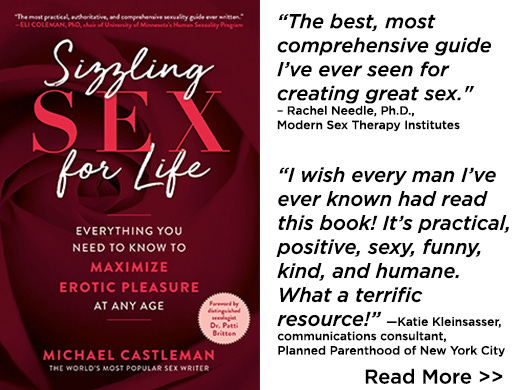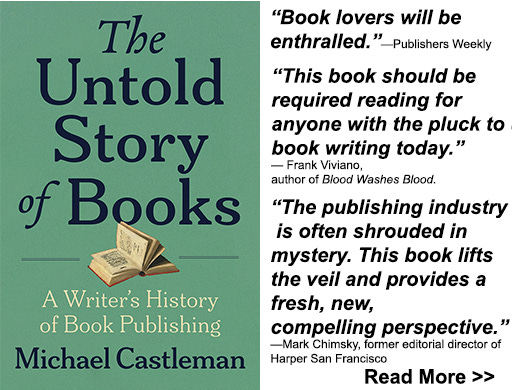Fifty Shades of Penis Size
Women’s sexual daydreams receive scant attention in the media, which have long been preoccupied with men’s erotic fantasies, namely pornography.
Romance fiction can teach men a great deal about women’s erotic fantasies.
I recently read all 1,625 pages of the wildly popular, mega-bestselling Fifty Shades trilogy: Fifty Shades of Grey, Fifty Shades Darker, and Fifty Shades Free.
I’m the only man I know who’s read any of them, let alone all three. Fifty Shades is romance fiction, a genre that’s almost exclusively the domain of women, just as pornography, romances’ opposite number, is largely the domain of men.
Why did I devour literature as foreign to my gender identity as tampons? Simple—Fifty Shades’ unprecedented, virtually unimaginable commercial success. Initially published by an obscure Australian Web site in 2011, the trilogy’s sales erupted like a dozen volcanoes. The New York Times says Fifty Shades has sold 165 million copies, making it one of the best-selling books of all time—in just a few years. (For comparison, it took the blockbuster, The DaVinci Code, 10 years to sell 25 million copies.)
I know several women who’ve read Fifty Shades, at least the first volume. A few didn’t care for it. But most finished it and all had similar reactions, smiling sheepishly and calling it a “guilty pleasure,” “kinky,” and “hot.”
Kinky, yes. Fifty Shades is filled with bondage, discipline, and sado-masochism (BDSM). But my reaction to the books mirrored how the vast majority of women feel about porn—confounded. I found the plot tedious, the characters cartoons, the dialogue lame, the writing pedestrian, and the graphic sex surprisingly dull. Of course, Fifty Shades wasn’t written to arouse my gender.
Still, I found the trilogy fascinating for the spotlight it shines on female erotic fantasies. Women’s sexual daydreams receive scant attention in the media, which have long been preoccupied with men’s erotic fantasies, namely pornography. Many women lose sleep over their men viewing porn, calling it perverted or infidelity or worse. Therapists have written books about the anguish porn causes women, the damage it can inflict on relationships, and how hapless men can wean themselves from “porn addiction.” But I’ve never known a single man to care in the least that his wife or girlfriend was hooked on romance fiction or visited any of the zillion heavily-trafficked Web sites devoted to it. And when I googled “romance fiction addiction,” I found no therapists, no twelve-step groups, just sites urging women to “feed your romance addiction.”
Many are sure to criticize me for calling romance fiction the flip side of porn. Many women insist that the two genres are polar opposites—and they have a point. The X-rated media deny love and relationships in favor of nonstop grinding body parts, while romance is all about relationships with the breathless sex an appropriate outgrowth of tumultuous love. Fair enough, but the larger truth is that both genres focus on gender-based erotic fantasies.
As it happens, gender-based fantasies are the subject of a recent book I found fascinating, A Billion Wicked Thoughts by Ogi Ogas and Sai Gaddam, two Ph.D.s in computer science. The book’s analysis is classically Darwinian and not new (below). But Ogas and Gaddam support it in a novel and provocative way—by using supercomputers to analyze more than 1 billion Web searches to plumb the depths of men’s and women’s erotic souls.
The co-authors assert that both genders’ sexual fantasies focus on every species’ fundamental mission in life, reproduction, the drive to pass genes to the next generation. Male genes are most likely to endure if men have sex with as many women as possible. As a result, men’s erotic fantasies deal with sex, sex, and more sex anywhere and everywhere with anyone and everyone. Meanwhile, female genes are most likely to survive if women raise children to sexual maturity, and their chances improve if they can domesticate men to stay with them long enough to accomplish the task. As a result, women’s erotic fantasies focus on long-term companionship with dashing hunks who are good providers.
In romance fiction, all the leading men are tall, buff, square-jawed, and physically overpowering, just like the main man in Fifty Shades, Christian Gray. The coauthors of A Billion Wicked Thoughts performed a text analysis on more than 10,000 romance novels published from 1983 through 2008 looking for the terms most frequently used to describe the men. They included: tall, lean, handsome, tanned, muscular, masculine, chiseled, jaw, shoulders, waist, and hips. In contrast, when men search the Web for porn, their top terms include: youth, MILFs, breasts, cheating wives, and vagina and its many off-color synonyms.
In romance fiction, the men’s physical size and domineering bearing speaks to women’s Darwinian yearning to feel protected so they can raise children safe from predators. The men in romance fiction are also consistently rich and powerful alpha males—kings, princes, knights, surgeons, industrialists, land barons—again answering women’s yearning to feel protected and safe. In Fifty Shades, Gray is an insufferably overbearing, impossibly successful, twenty-something billionaire, who delights in lavishing his immense fortune on his innocent, wide-eyed love, Anastasia Steele.
In addition, the leading men in romance fiction are always dangerous. In women’s fantasies, this serves two key purposes. Bad-boy men are wily enough to prevail against threats to the heroine. And being involved with dangerous men allows the women to use their irresistible erotic magnetism, to control their tall, rich, difficult, powerful studs, and against all odds, tame them into lifelong devotion, domesticity, and fatherhood.
In Fifty Shades, Grey is dangerous because he’s deep into kinky sex, delighting in the dominant side of BDSM. His penthouse Taj Mahal is fitted with a private playroom full of whips, chains, and butt plugs he has used on a parade of willingly submissive gals. For a while, Steele plays along (reluctantly), but her erotic allure is so powerful, so compelling, and so irresistible, that she not only tames her dangerous man, but also extracts him from kink and converts him to the joys of conventional sex, marriage, and fatherhood.
Which brings me to penis size. Every time I’ve written that it doesn’t matter to the large majority of women, I get a slew of derisive comments from both genders insisting that size matters a great deal. Yes, penis size matters to a small proportion of women—15 percent according to a 2006 study of 50,000 women in the journal Psychology of Men and Masculinity. But eye-tracking studies show that women gaze at men’s crotches no more frequently than they look at any other male body part. In the Ogas-Gaddam text analysis of male descriptors in romance novels, the word “penis” is nowhere to be found. And in 1,625 pages, Fifty Shades mentions penis size only once, when Steele first spies Grey’s endowment. She doesn’t swoon, or pull out a ruler or camera, or yearn to feel stretched like a rubber band. Her only comment is that what Gray carries between his legs is so vague that could mean almost anything.
Meanwhile, whenever Steele and Grey embrace—every time—he gets rock hard and she delights in his erections. At least a hundred times in the three books, she chirps: “I felt his erection press against me.” She doesn’t care a bit about Grey’s size, just his turgidity—because in women’s fantasies, it’s not about the man’s equipment. It’s about the woman’s mojo, her magical, magnetic power to arouse her alpha male and keeps his attention focused exclusively on her.
So, folks, if you’re convinced that women want a guy with a phone pole between his legs, there’s probably nothing I can do to change your mind. But the 165 million women who have read Fifty Shades of Grey—more than one-third of the nation’s adult female population—never discover the dimensions of what resides in Christian Grey’s underwear. Instead, over and over again, they read about what women really fantasize about—their yearning to be irresistible and possess magical erotic power over men.
[scroll down for related Questions & Answers]
References
Fifty Shades of Gray. Fifty Shades Darker. Fifty Shades Free. Writer’s Coffee Shop, 2011, then Vintage, 2012.
Ogas, O. and S. Gaddam. A Billion Wicked Thoughts. Plume, 2011.
Lever, J. et al. “Does Size Matter? Men’s and Women’s Views on Penis Size Across the Lifespan,” Psychology of Men and Masculinity (2006) 7:129.
Questions & Answers
I’ve answered more than 12,000 sex questions from people around the world, of all ages, for free. Here are a few that relate to the topic of this post.
If you’d like to ask me a question of your own, please go to GreatSexGuidance.com.
A story you’ve heard before. One of her exes was bigger, and she recalls the sex was better. Somehow current man finds out. She wants him to put it out of his mind; she loves him dearly. Read more and my response…
How do you get women to stop believing their partner has to have a large penis? I have been told by past girlfriends that I have a small penis and they are breaking up with me to find someone with a large penis. People say size doesn’t matter and yet women seem to go for the guy that has the largest bulge in their pants. Why is that? Read my response…
My boyfriend has a very large penis and I have not had sex in over 8 years. We’re having trouble with intercourse. We are in our 60s and he is very active and interested. Read my response…
Very interesting site. Very useful information. But I’m insecure about my penis size. Can a woman who had a well endowed boyfriend, then go and marry a guy that is not well endowed? I’m on the small side, 5 1/2″, officially normal, however I fell insecure, and an extra inch or two would be nice. My wife says that I’m the best she has had. How could she feel that way after being with a well-endowed man? Read my response…







I've read the Fifty Shades trilogy (as has my husband, so you're not the only man to have read it, Michael!), but it had never struck me that Christian's penis size is never discussed. The wild success of the book is such a fascinating social phenomenon, and this is an aspect to it I had never thought about. So interesting! Thank you for sharing.